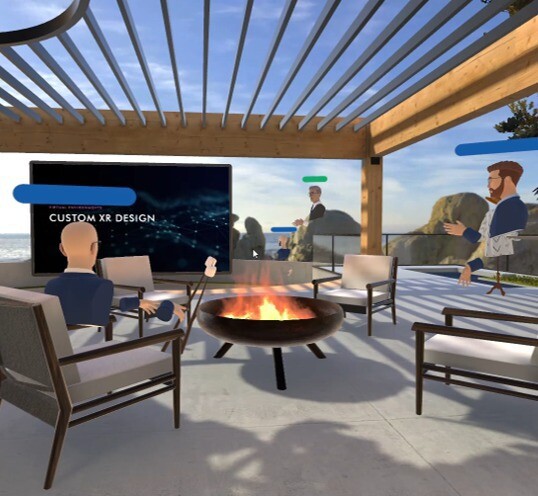
The evolution of architecture and design has always been impacted by the zeitgeist. Whether it was Modernism, globalization, or tech-firm culture, design has responded to reflect and at times define societal influences. Now, due in part to a mass exodus from the traditional workplace, we once again have an opportunity to reimagine the nature of space and place in design.
A global pandemic in conjunction with web-based meeting tech has fueled a transformation in how and where we work. The desire to have more freedom in our blending of work and life is significantly impacting workplace design. Combine that with the much-cited “Zoom Burnout” and the massive interest in Extended Reality (XR)—a combination of virtual reality, augmented reality, and mixed reality tools (fig. 1)—we can see that working and collaborating in the metaverses starts making a lot more sense. By applying and adapting our skillsets to the new parameters inherent in virtualized experiences, where the normal confines of physical space (gravity, for example) do not exist, we can stake our place in this new paradigm and build truly engaging spaces at a time when our industry could benefit from a shakeup.

Through our work with clients, we have seen direct evidence of virtual interaction creating an engaging and potentially more meaningful human connection by focusing on the concept of “co-presence”, e.g., where people perceive they are when they are engaged in real-time, face-to-face interaction. This in turn creates opportunities to reimagine “real-world" spaces, such as meeting rooms that support XR interfaces.
Good design matters, whether in real or virtual worlds. A fundamental transformation in the possibilities of design has occurred: We are now designers and builders of virtual spaces and the interfaces inherent in how we engage them. To best design metaverses, designers need to be the lead—or at least a key collaborator—in their construction. Understanding how to choose the tools, interactions, and limitations of XR platforms to best align with the project goals is as critical as the decisions of lighting and materiality.
We can unpack this more deliberately by exploring several current use cases.

XR Design
XR Design is the use of XR technologies to assist in the design and construction of the built environment. Most effectively, this is used in conjunction with Building Information Modeling software, like Revit, to allow for rapid ideation and fidelity to the design model. While Virtual Reality (VR) and Augmented Reality (AR) for design have been around for many years, ease of entry and comfort with the new toolsets available now place this workflow firmly in the grasp of many project teams, allowing us to fully inhabit the spaces we create long before occupancy. XR Design has the potential to connect creators and clients in a far more meaningful way than the current palette of documentation and visualization. A recent example is the build-out of virtual spaces that clone existing structures but show new possibilities for interiors, enabling building owners to further engage with their potential tenants by customizing options (fig. 2).

Custom XR Environments
Here we create bespoke environments, often informed by existing real-world spaces and their branding and materiality, that allow freedom in siting, elevation, and scale. We have found that clients who initially commit to “twinning” an existing space unanimously choose to customize and expand upon the design with XR tools once they experience the possibilities. Higher ceilings, top floor views, outdoor spaces with “live” biophilia moving in the virtual breeze—all and more are possible with XR, but prohibitive in real life. These spaces can be programmed for an emphasis on openness and flow with a minimum of enclosed meeting rooms, accommodating multiple-use models, from structured meeting places to drop-in social areas, all in the same environment, if desired. These possibilities represent what people are really looking for in spaces, but often cannot have given real-world constraints. Our IA Atlanta XR project was our discovery point in understanding the human aspect of XR. By moving the virtual location from midtown Atlanta to the South African coast—shifting focus from workstations and meeting rooms to open social and collaboration spaces, and adding elemental interactions with biophilia—we discovered that people experienced significantly higher levels of engagement and comfort than they did with web calls, which simply don’t provide this level of immersive experience (fig. 3).
Once clients have experienced these custom XR worlds, they tend to want to utilize them for purposes beyond internal meetings and hangouts. These new uses include employee onboarding and customer experience.
Employee Onboarding
The new requirement of remote hiring practices and the limitations therein have caused the process of onboarding to be reevaluated and found lacking. We are populating our clients’ custom XR environments with interrelated, experiential design-driven content such as video, signage, games, and interactions that help tell the company's story and better connect new hires with the company culture, history, and values in an immersive and engaging place that they can access from anywhere. We’re currently working with a client that is investing in the development of a virtual environment; they are sending new hires VR headsets so they can engage in a self-guided experience, and then gather with other new staffers in freshly created social spaces. The feedback from the client’s team and the new staff was unanimously in favor of the XR experiences over the old process of watching videos and filling out forms.

Customer Experience
Customer engagement in an era of dispersed locations and the desire to lower carbon footprints pose challenges. By building environments expressly for interacting, educating, and listening to customers, our clients are finding success in communicating information previously considered deliverable in person only. For example, we took a successful physical workplace design for a client and recrafted it into a virtual, interactive space for their use connecting with customers. The original built space was on the third floor; we moved its virtual counterpart to the 61st floor of the tower and created the “views” with high-resolution imagery. The overall layout of the physical workplace was recreated to follow a tour path, from the entry to the conference space, into large social spaces, then into the main presentation hall, and finishing in the “selfie room” to give everyone attending a virtual souvenir photo of their group with the crafted “views” in the background. The client received a warm reception from their customers, who were asked to don a VR headset, taught how to use it, and attend sessions featuring agendas tailored for them. They found engagement and feedback quite positive and continue to use the virtual space consistently (fig. 4).
Architects and designers have a role in the metaverses, if they choose to believe that design can be part of creating virtual spaces that matter. Fundamentally, designing with 3D tools for real-world projects on 2D screens no longer makes sense. User experience in technology interfaces is important, but our reality shows us design gives these new worlds usefulness and longevity. XR, metaverses, virtual worlds, and so on are here to stay, and we can prove that the place we have in their creation is as important as the technology that drives them.
Read more: Phyllis Kim on embedding yourself in the community|Melanie Fairchild and Jessica Dole on parental leave in the architecture profession|Gabriel Keller on alternative paths to professional licensure

















